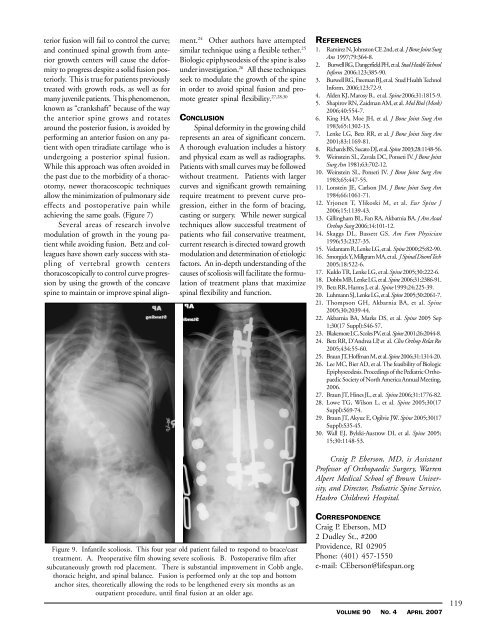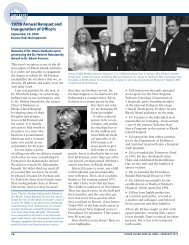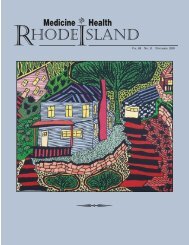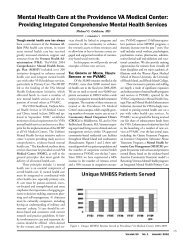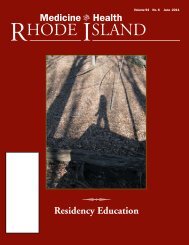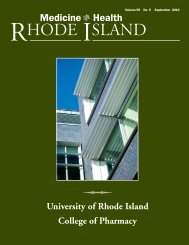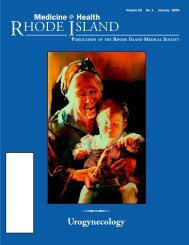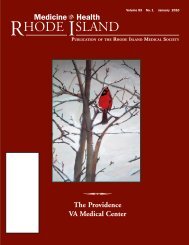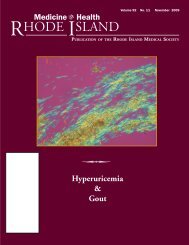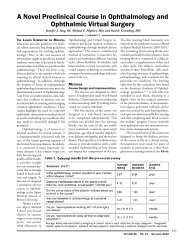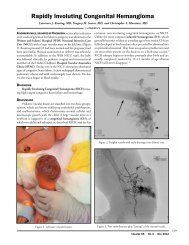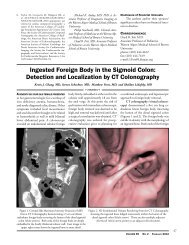April 2007 - Division of Biology and Medicine - Brown University
April 2007 - Division of Biology and Medicine - Brown University
April 2007 - Division of Biology and Medicine - Brown University
You also want an ePaper? Increase the reach of your titles
YUMPU automatically turns print PDFs into web optimized ePapers that Google loves.
terior fusion will fail to control the curve;<br />
<strong>and</strong> continued spinal growth from anterior<br />
growth centers will cause the deformity<br />
to progress despite a solid fusion posteriorly.<br />
This is true for patients previously<br />
treated with growth rods, as well as for<br />
many juvenile patients. This phenomenon,<br />
known as “crankshaft” because <strong>of</strong> the way<br />
the anterior spine grows <strong>and</strong> rotates<br />
around the posterior fusion, is avoided by<br />
performing an anterior fusion on any patient<br />
with open triradiate cartilage who is<br />
undergoing a posterior spinal fusion.<br />
While this approach was <strong>of</strong>ten avoided in<br />
the past due to the morbidity <strong>of</strong> a thoracotomy,<br />
newer thoracoscopic techniques<br />
allow the minimization <strong>of</strong> pulmonary side<br />
effects <strong>and</strong> postoperative pain while<br />
achieving the same goals. (Figure 7)<br />
Several areas <strong>of</strong> research involve<br />
modulation <strong>of</strong> growth in the young patient<br />
while avoiding fusion. Betz <strong>and</strong> colleagues<br />
have shown early success with stapling<br />
<strong>of</strong> vertebral growth centers<br />
thoracoscopically to control curve progression<br />
by using the growth <strong>of</strong> the concave<br />
spine to maintain or improve spinal alignment.<br />
24 Other authors have attempted<br />
similar technique using a flexible tether. 25<br />
Biologic epiphyseodesis <strong>of</strong> the spine is also<br />
under investigation. 26 All these techniques<br />
seek to modulate the growth <strong>of</strong> the spine<br />
in order to avoid spinal fusion <strong>and</strong> promote<br />
greater spinal flexibility. 27,28,30<br />
CONCLUSION<br />
Spinal deformity in the growing child<br />
represents an area <strong>of</strong> significant concern.<br />
A thorough evaluation includes a history<br />
<strong>and</strong> physical exam as well as radiographs.<br />
Patients with small curves may be followed<br />
without treatment. Patients with larger<br />
curves <strong>and</strong> significant growth remaining<br />
require treatment to prevent curve progression,<br />
either in the form <strong>of</strong> bracing,<br />
casting or surgery. While newer surgical<br />
techniques allow successful treatment <strong>of</strong><br />
patients who fail conservative treatment,<br />
current research is directed toward growth<br />
modulation <strong>and</strong> determination <strong>of</strong> etiologic<br />
factors. An in-depth underst<strong>and</strong>ing <strong>of</strong> the<br />
causes <strong>of</strong> scoliosis will facilitate the formulation<br />
<strong>of</strong> treatment plans that maximize<br />
spinal flexibility <strong>and</strong> function.<br />
REFERENCES<br />
1. Ramirez N, Johnston CE 2nd, et al. J Bone Joint Surg<br />
Am 1997;79:364-8.<br />
2. Burwell RG, Dangerfield PH, et al. Stud Health Technol<br />
Inform 2006;123:385-90.<br />
3. Burwell RG, Freeman BJ, et al. Stud Health Technol<br />
Inform. 2006;123:72-9.<br />
4. Alden KJ, Marosy B,. et al. Spine 2006;31:1815-9.<br />
5. Shapirov RN, Zaidman AM, et al. Mol Biol (Mosk)<br />
2006;40:554-7.<br />
6. King HA, Moe JH, et al. J Bone Joint Surg Am<br />
1983;65:1302-13.<br />
7. Lenke LG, Betz RR, et al. J Bone Joint Surg Am<br />
2001;83:1169-81.<br />
8. Richards BS, Sucato DJ, et al. Spine 2003;28:1148-56.<br />
9. Weinstein SL, Zavala DC, Ponseti IV. J Bone Joint<br />
Surg Am 1981;63:702-12.<br />
10. Weinstein SL, Ponseti IV. J Bone Joint Surg Am<br />
1983;65:447-55.<br />
11. Lonstein JE, Carlson JM. J Bone Joint Surg Am<br />
1984;66:1061-71.<br />
12. Yrjonen T, Ylikoski M, et al. Eur Spine J<br />
2006;15:1139-43.<br />
13. Gillingham BL, Fan RA, Akbarnia BA. J Am Acad<br />
Orthop Surg 2006;14:101-12.<br />
14. Skaggs DL, Bassett GS. Am Fam Physician<br />
1996;53:2327-35.<br />
15. Vedantam R, Lenke LG, et al. Spine 2000;25:82-90.<br />
16. Smorgick Y, Millgram MA, et al. J Spinal Disord Tech<br />
2005;18:522-6.<br />
17. Kuklo TR, Lenke LG, et al. Spine 2005;30:222-6.<br />
18. Dobbs MB, Lenke LG, et al. Spine 2006;31:2386-91.<br />
19. Betz RR, Harms J, et al. Spine 1999;24:225-39.<br />
20. Luhmann SJ, Lenke LG, et al. Spine 2005;30:2061-7.<br />
21. Thompson GH, Akbarnia BA, et al. Spine<br />
2005;30:2039-44.<br />
22. Akbarnia BA, Marks DS, et al. Spine 2005 Sep<br />
1;30(17 Suppl):S46-57.<br />
23. Blakemore LC, Scoles PV, et al. Spine 2001;26:2044-8.<br />
24. Betz RR, D’Andrea LP, et al. Clin Orthop Relat Res<br />
2005;434:55-60.<br />
25. Braun JT, H<strong>of</strong>fman M, et al. Spine 2006;31:1314-20.<br />
26. Lee MC, Bier AD, et al. The feasibility <strong>of</strong> Biologic<br />
Epiphyseodesis. Procedings <strong>of</strong> the Pediatric Orthopaedic<br />
Society <strong>of</strong> North America Annual Meeting,<br />
2006.<br />
27. Braun JT, Hines JL, et al. Spine 2006;31:1776-82.<br />
28. Lowe TG, Wilson L, et al. Spine 2005;30(17<br />
Suppl):S69-74.<br />
29. Braun JT, Akyuz E, Ogilvie JW. Spine 2005;30(17<br />
Suppl):S35-45.<br />
30. Wall EJ, Bylski-Austrow DI, et al. Spine 2005;<br />
15;30:1148-53.<br />
Craig P. Eberson, MD, is Assistant<br />
Pr<strong>of</strong>essor <strong>of</strong> Orthopaedic Surgery, Warren<br />
Alpert Medical School <strong>of</strong> <strong>Brown</strong> <strong>University</strong>,<br />
<strong>and</strong> Director, Pediatric Spine Service,<br />
Hasbro Children’s Hospital.<br />
Figure 9. Infantile scoliosis. This four year old patient failed to respond to brace/cast<br />
treatment. A. Preoperative film showing severe scoliosis. B. Postoperative film after<br />
subcutaneously growth rod placement. There is substantial improvement in Cobb angle,<br />
thoracic height, <strong>and</strong> spinal balance. Fusion is performed only at the top <strong>and</strong> bottom<br />
anchor sites, theoretically allowing the rods to be lengthened every six months as an<br />
outpatient procedure, until final fusion at an older age.<br />
CORRESPONDENCE<br />
Craig P. Eberson, MD<br />
2 Dudley St., #200<br />
Providence, RI 02905<br />
Phone: (401) 457-1550<br />
e-mail: CEberson@lifespan.org<br />
VOLUME 90 NO. 4 APRIL <strong>2007</strong><br />
119


